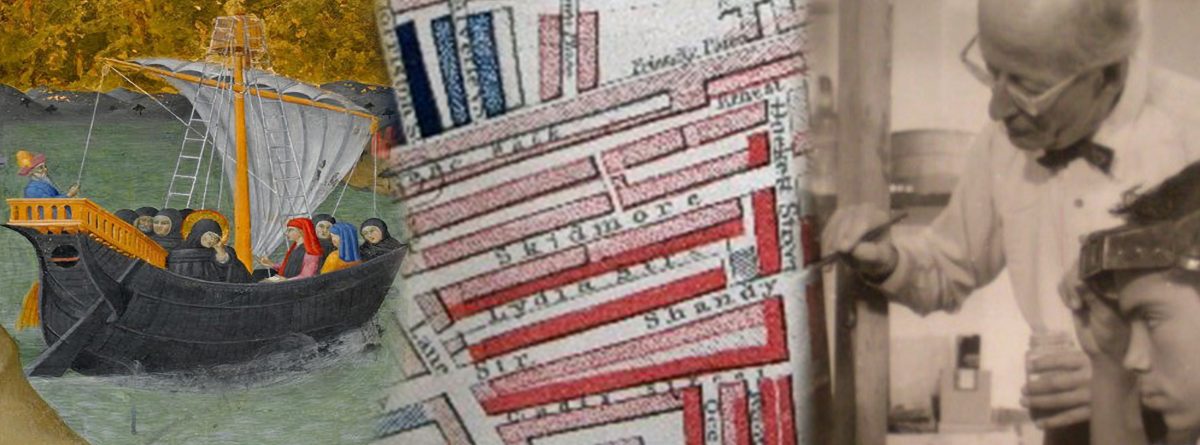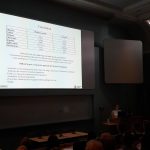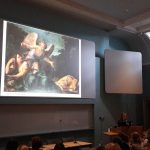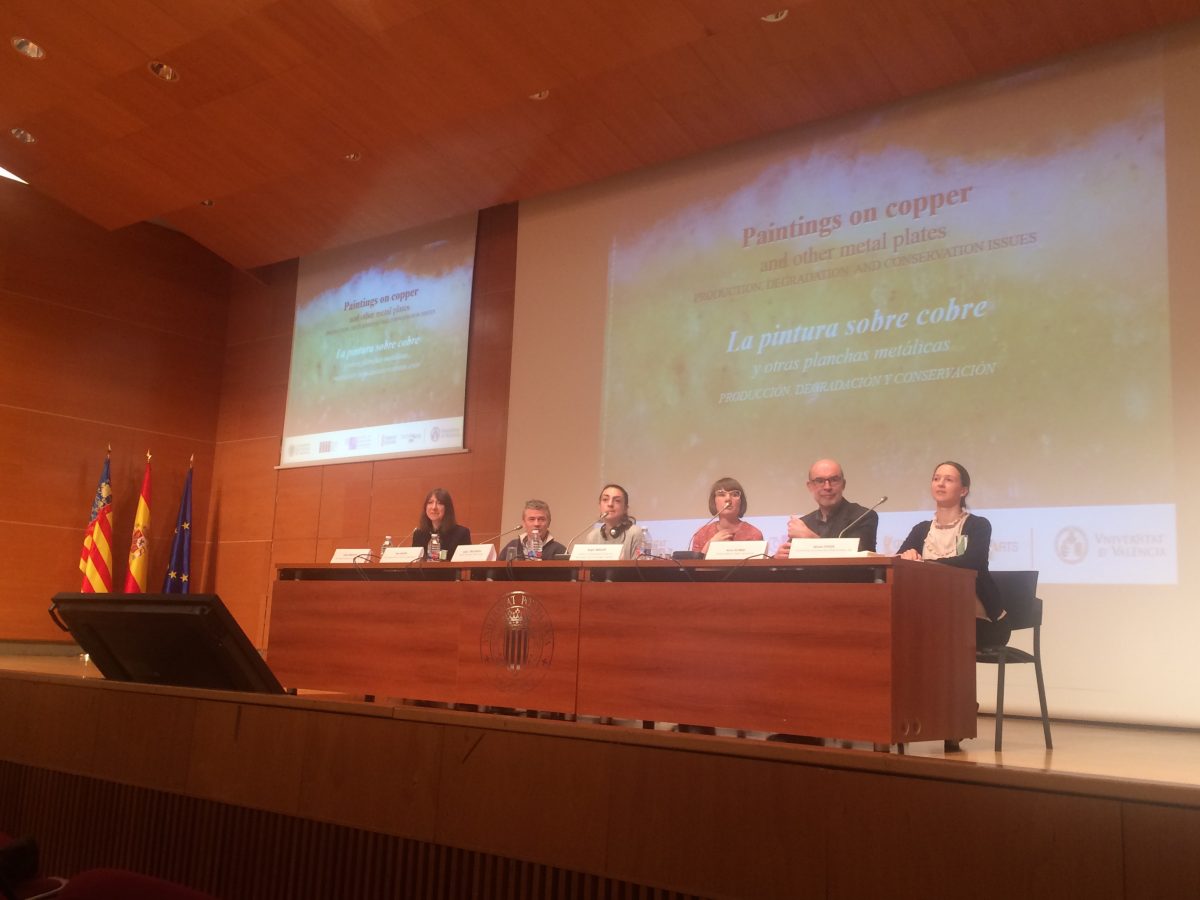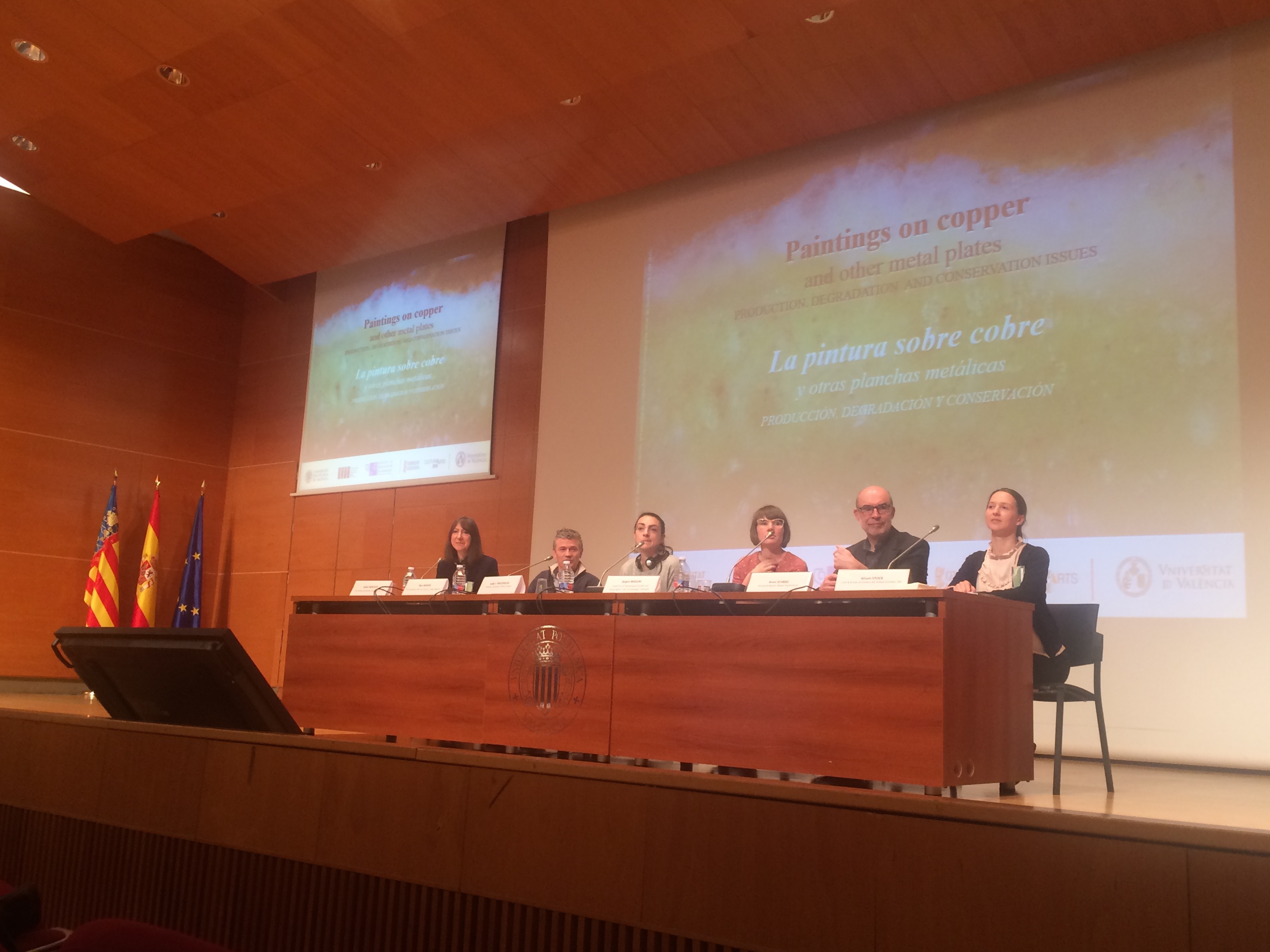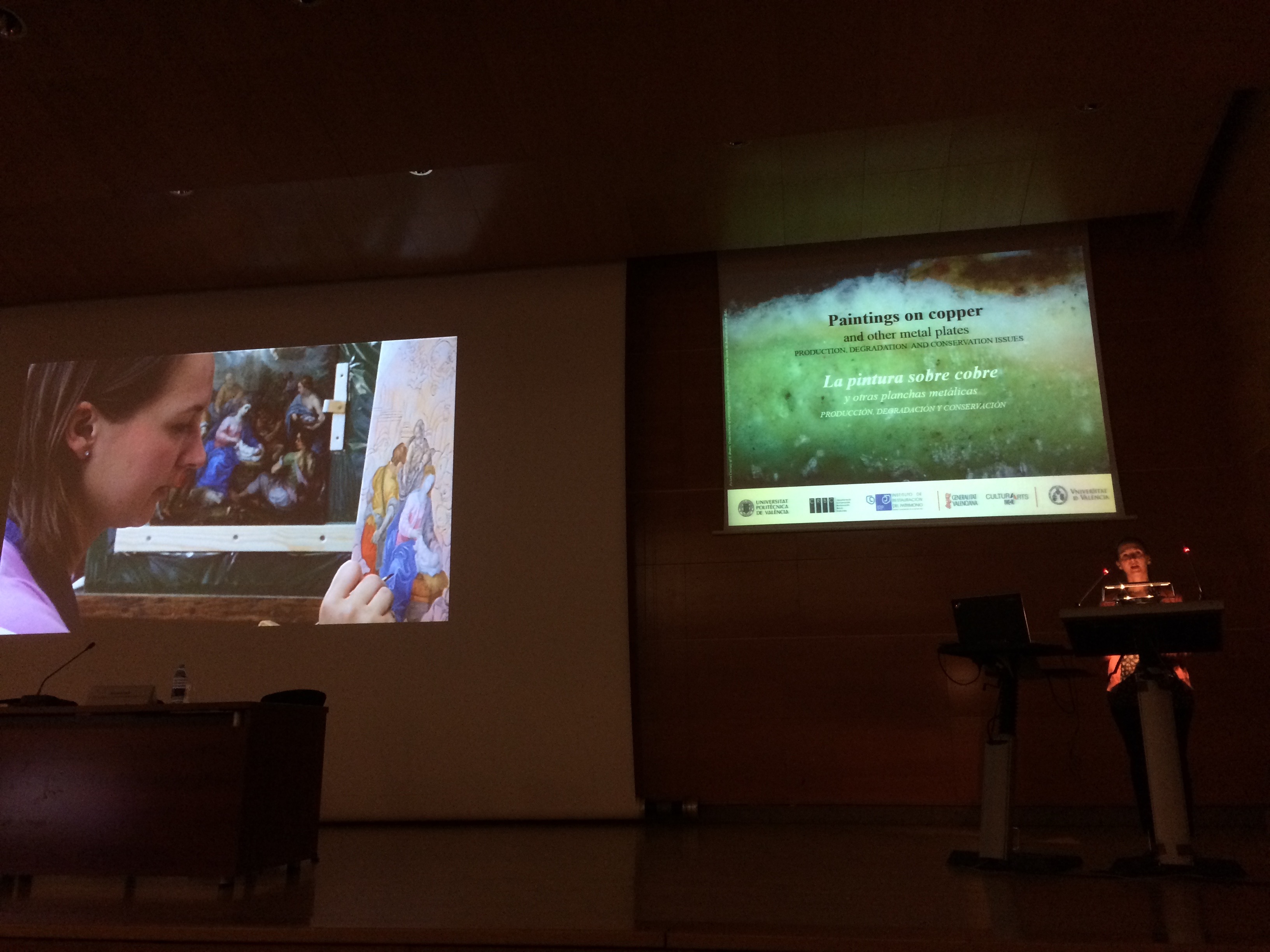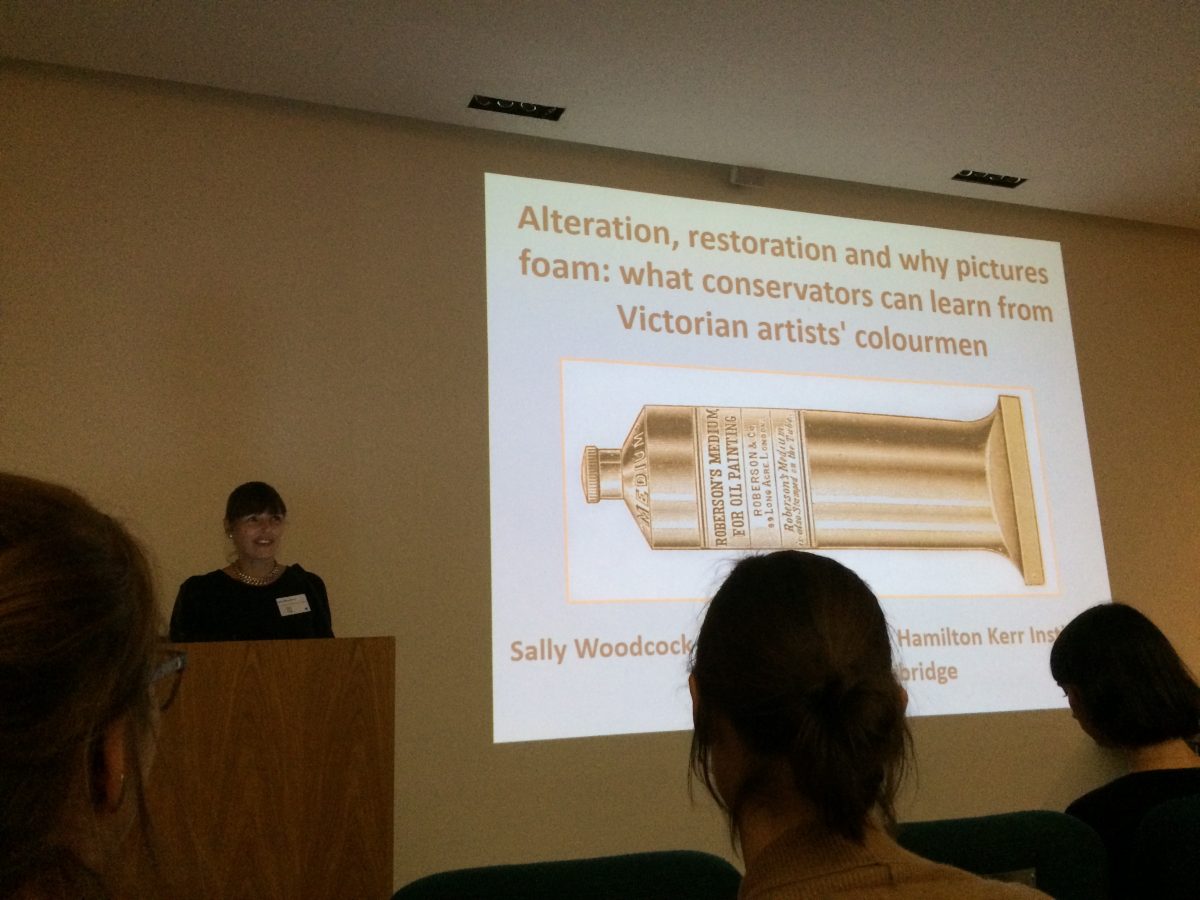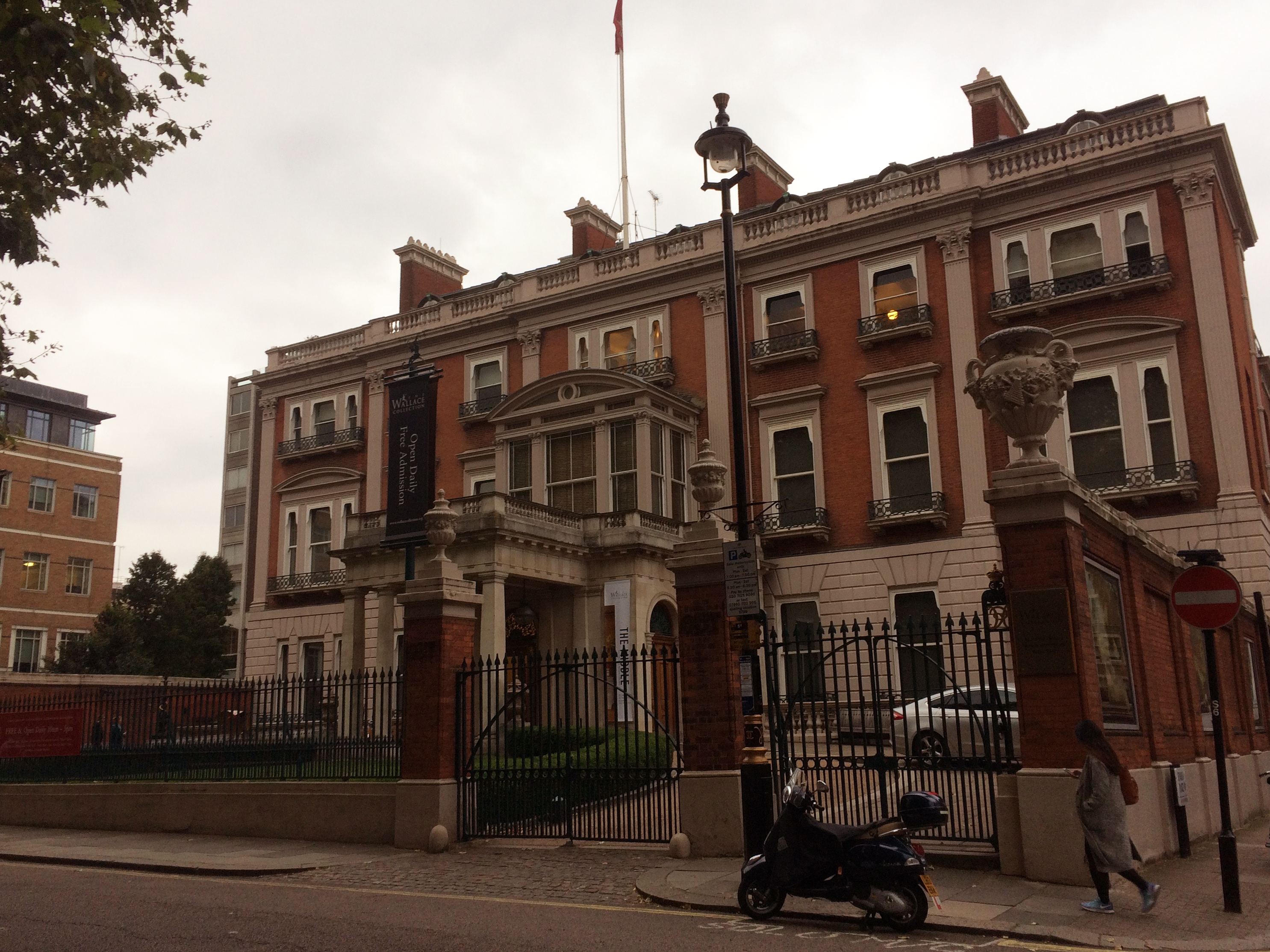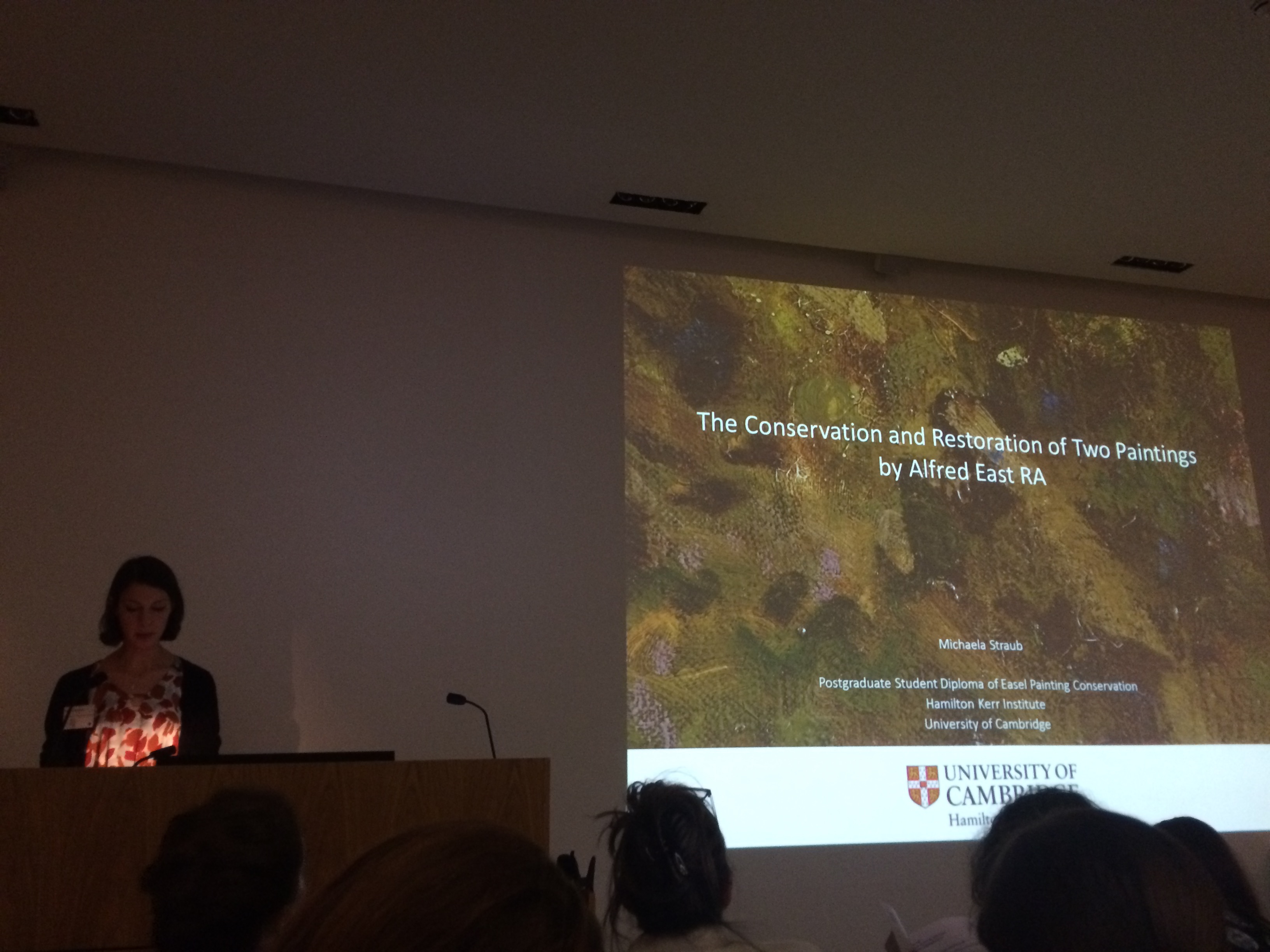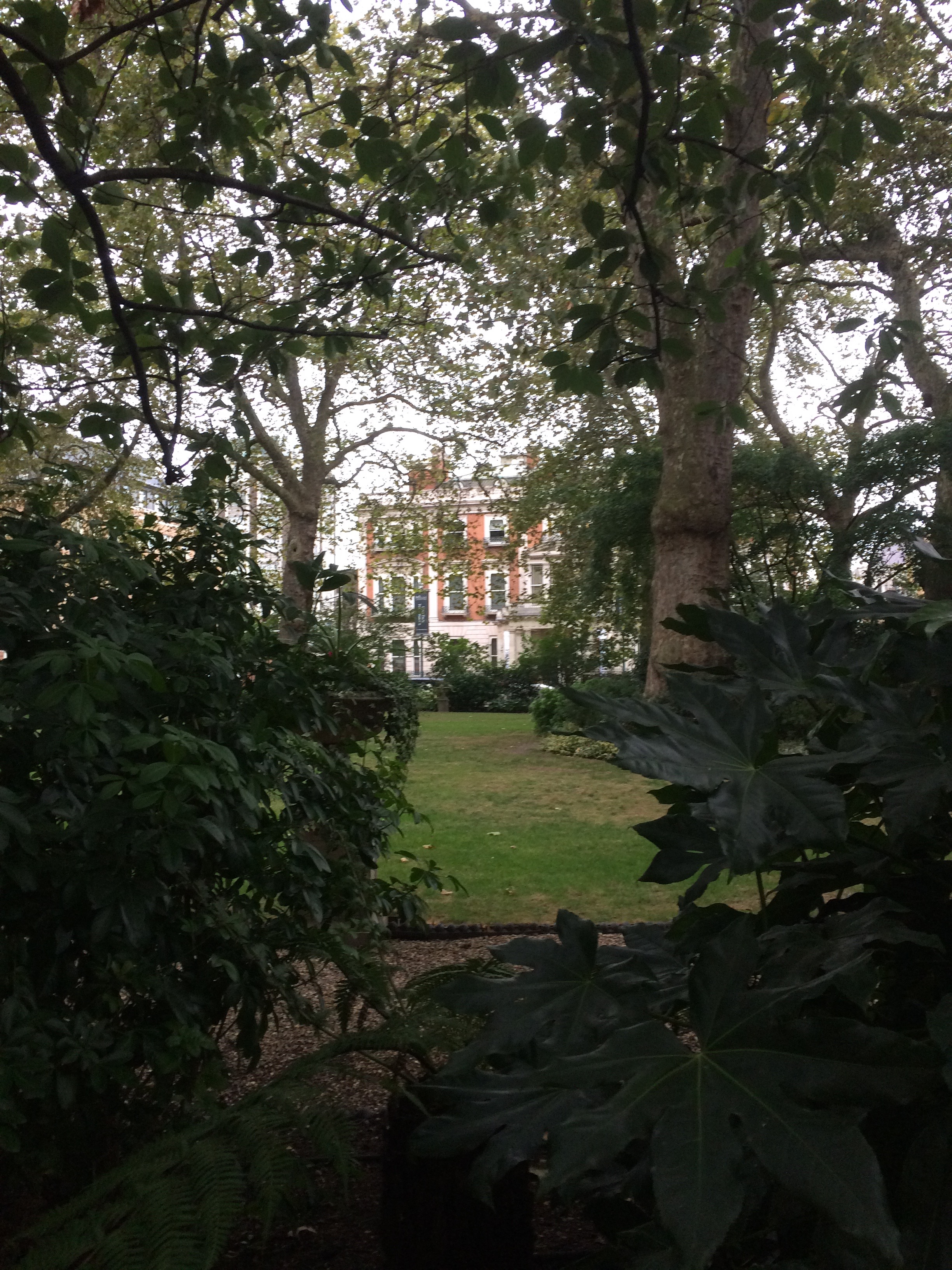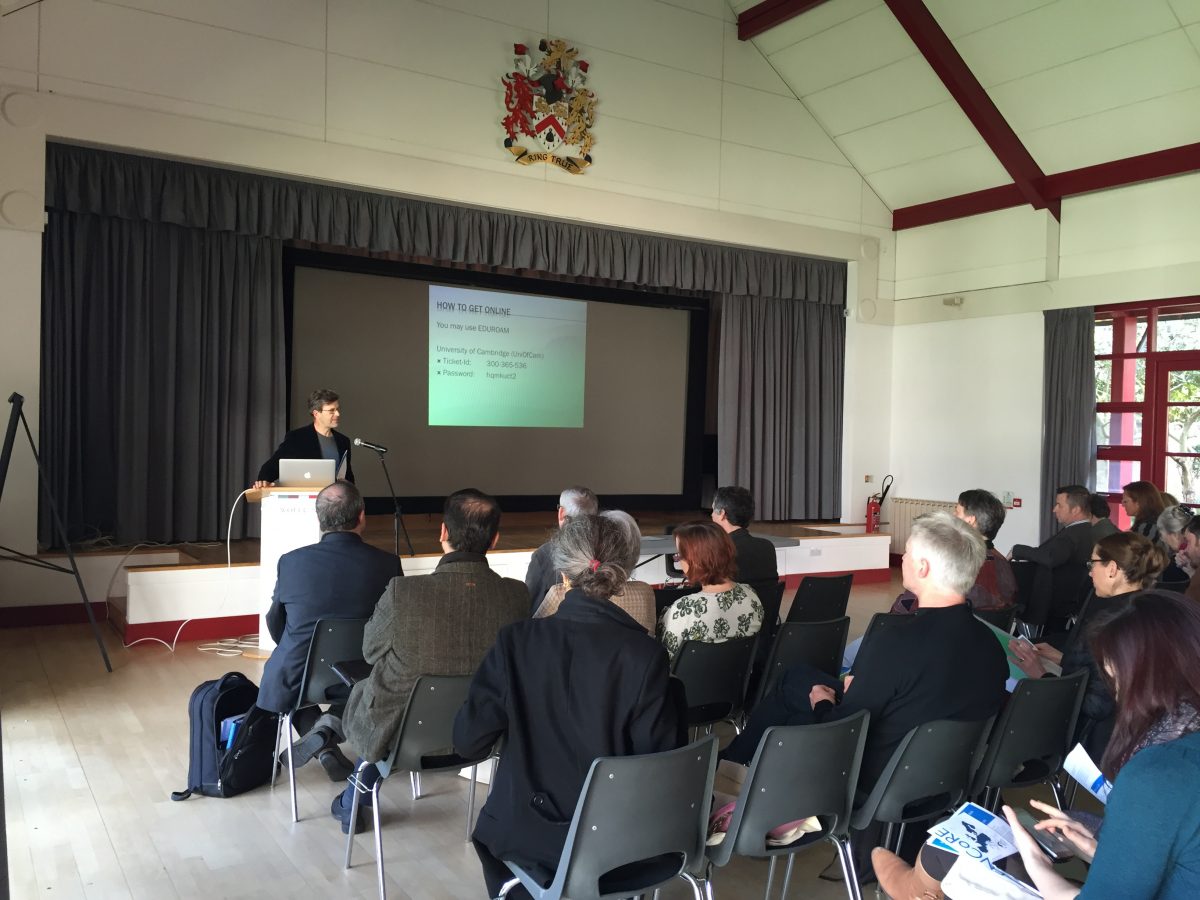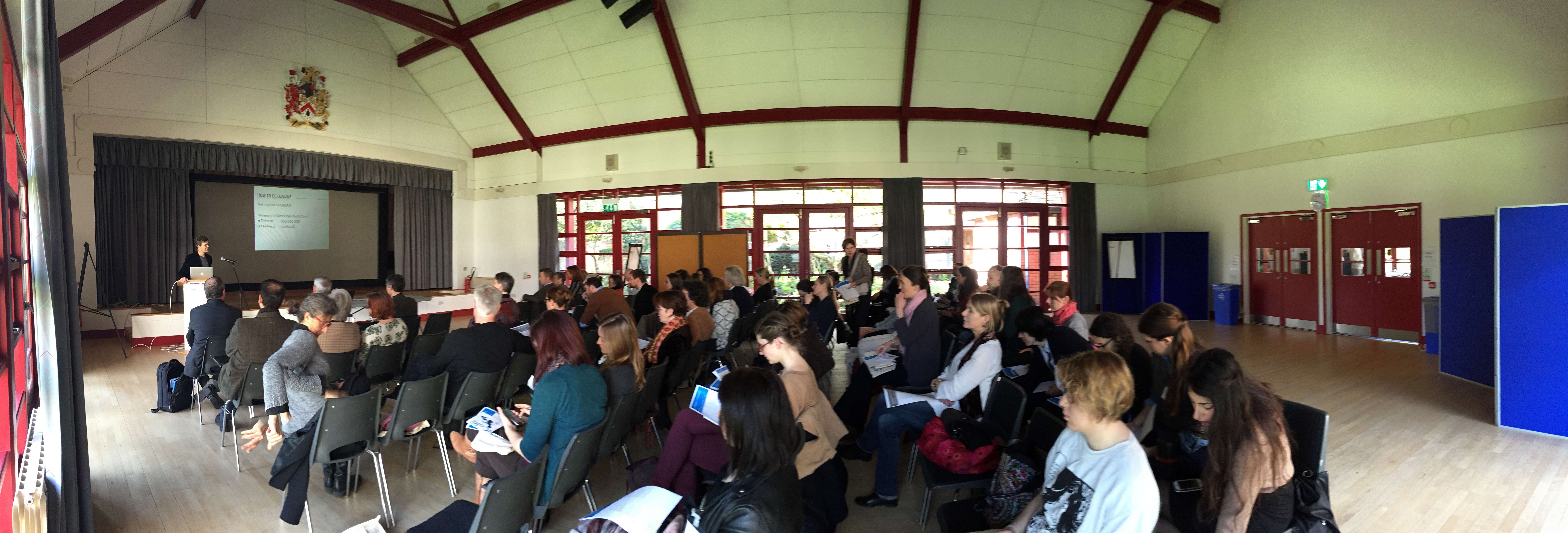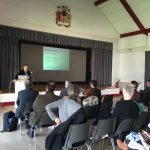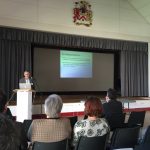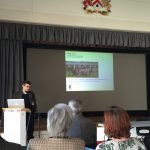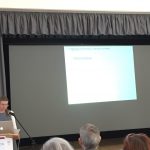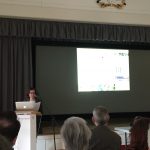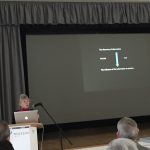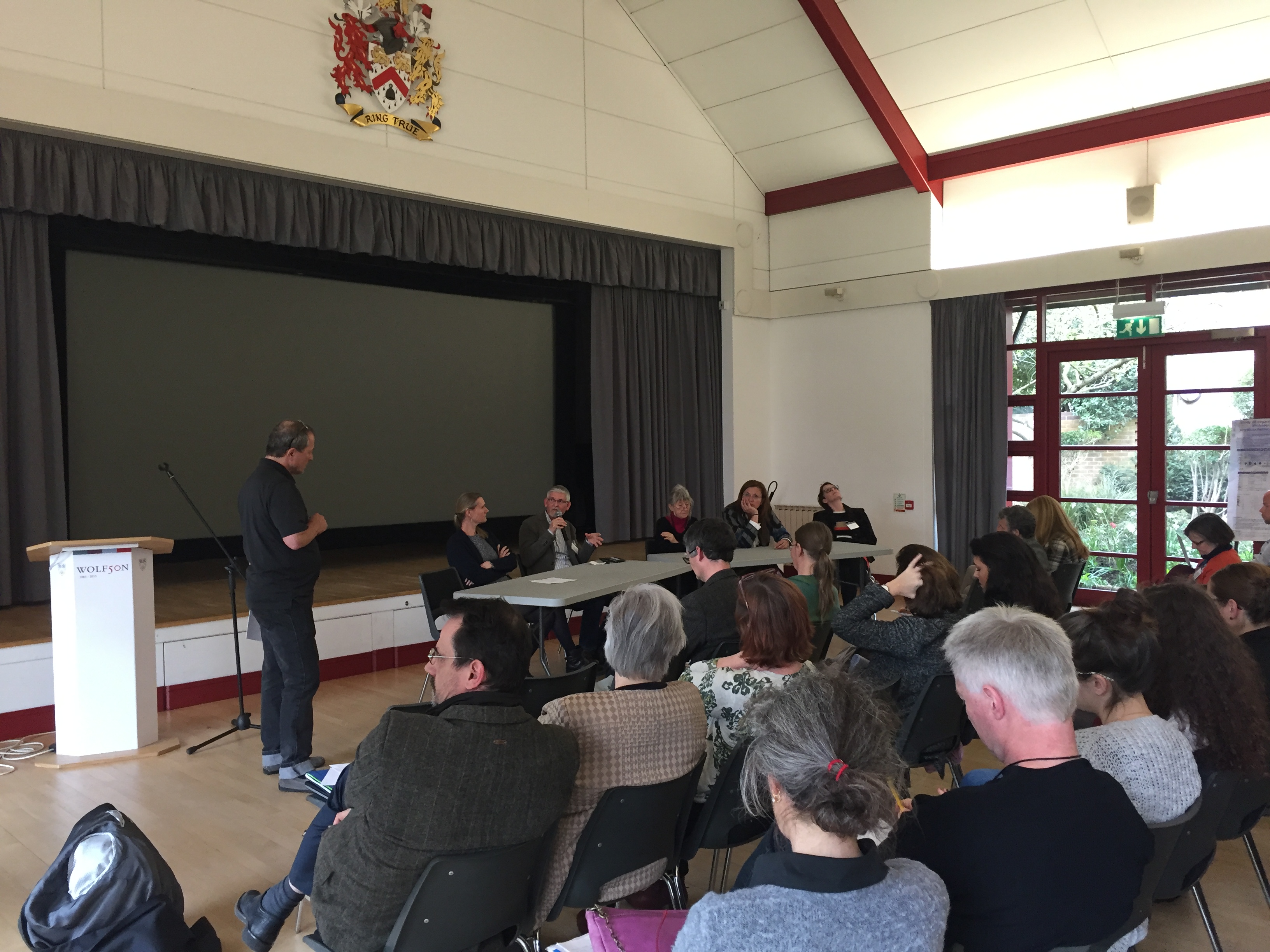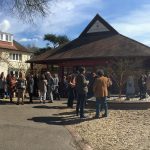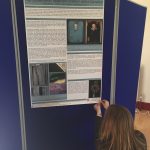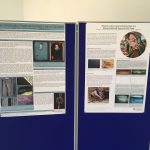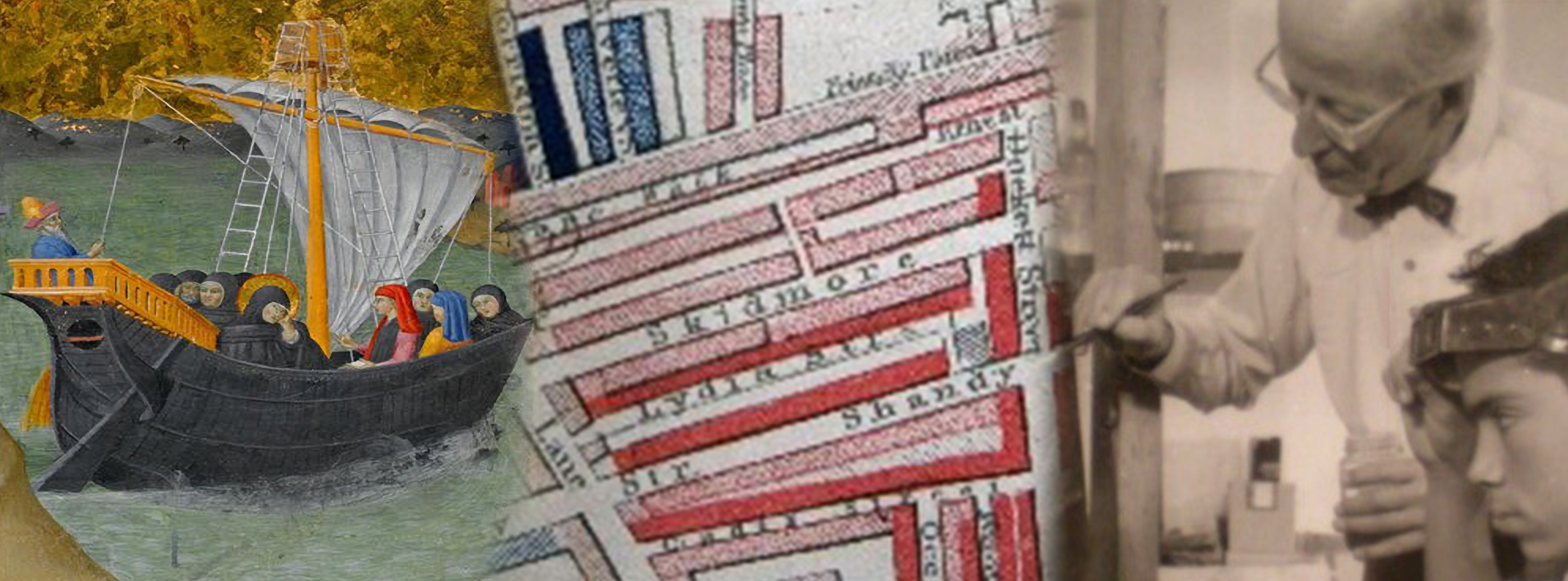 This two-day interdisciplinary conference, hosted by the Hamilton Kerr Institute and held at the Murray Edwards College, University of Cambridge, featured talks that explored how artists, conservators and their materials, ideas and techniques have crossed borders from antiquity to the modern day (click here for the full programme). The artworks discussed were diverse, not only paintings but sculpture, mosaics, textiles, architecture and archaeological finds, and the speakers addressed issues of war, trade, exploitation, individual personalities and the transmission of information across localities and time. It was an opportunity to bring together people from different countries and cultures, and share research from a number of disciplines in the arts, sciences and humanities.
This two-day interdisciplinary conference, hosted by the Hamilton Kerr Institute and held at the Murray Edwards College, University of Cambridge, featured talks that explored how artists, conservators and their materials, ideas and techniques have crossed borders from antiquity to the modern day (click here for the full programme). The artworks discussed were diverse, not only paintings but sculpture, mosaics, textiles, architecture and archaeological finds, and the speakers addressed issues of war, trade, exploitation, individual personalities and the transmission of information across localities and time. It was an opportunity to bring together people from different countries and cultures, and share research from a number of disciplines in the arts, sciences and humanities.
Dr Kristin Kausland (Norwegian Institute of Cultural Heritage Research/Hamilton Kerr Institute) began the first session, ‘Art and Artists’, with her talk on the manufacture of Scandinavian altarpieces in the late Middle Ages, considering the contribution of immigrant Northern German artists to their fabrication, as well as the import of objects. Presenting results of detailed technical study of several altarpieces, she highlighted the amalgamative nature of these superstructures, clues in regional techniques such imitation gold, and the use of model books through generations of craftsmen. We are greatly looking forward to welcoming Dr Kausland at the HKI in February as she carries out her post-doctoral research.
Jessica David, representing the Yale Centre for British Art and colleague Edward Town, presented research exploring the work of the 16th-century artist Netherlandish Daniël van den Queborn, who served a British client base formed of military men who fought in his homeland during the Dutch Revolt. From in-depth examination of his works, the authors built an interesting portrait of a versatile artist who, in his role as ‘court’ painter to the House of Orange, built his career on diplomacy. Records from the RKD database were consulted, a resource cited as an example of instantaneous accessibility to knowledge that enables us to virtually traverse geographical distance and time today.
Javier Grossutti (Swinburne University of Technology) introduced us to terrazzo, a form of mosaic flooring seen in many buildings in the UK and Italy. Grossutti led us from the craft’s 16th-century origins in the Italian town of Friuli and its development in the 19th century under Pietro Mazzioli, who travelled to England and established a factory in London. We were given a sense of the sheer scale of the industry from the pictures of familiar places such as the National Portrait Gallery, but also buildings in other British towns and cities.
Pia Gottschaller (The Courtauld Institute of Art) discussed the Asociación Arte Concreto-Invención (AACI) movement in Argentina, Uruguay and Brazil from the 1940s to the 1960s. She set out a vivid picture of the artistic network established and highlighted the artists’ experimentation with new media, enabling them to communicate their ideas in a new way. Gottschaller reminded us that the travel of the artists in the 20th century, when journeys were expensive and long, might be considered just as striking a feat as Queborn’s establishment of an international client base in the 17th. On the other hand, Gottschaller also noted that these factors, and language barriers, continue to inhibit communication today, contributing to the dearth of scholarship on Concrete artists.
Beginning session 2, ‘Conservators and Conservation’, Dr Caitlin O’Grady (University College London) talked about the use of wax in the preservation of archaeological artefacts in the early 20th century, centring on the work of Sir William Matthews Flinders Petrie who led new developments in the preservation of excavated artefacts. O’Grady showed how the use of wax in the field became a recognised practice, and how the paucity of documentary evidence means that now, much of the information regarding the use of wax must come from the objects themselves. She also defined the role of ‘boundary work’ between archaeologists, scientists and curators in the spread of knowledge about such techniques for preservation.
Katya Belaia (National Trust) and Valeriia Kravchenko (Museum of Ukrainian Art) spoke on the history of conservation in the Ukraine and the issues faced by conservators working in a Soviet society. They highlighted the work of conservators who worked in the Soviet era to preserve objects that were forcefully disregarded at the time. It was particularly interesting to hear about the structure and content of conservation training programmes in the Ukraine today, where there remain restrictions against conservators working on a freelance basis. It was remarked that destruction of cultural property is still seen there today with attempts to abolish remnants of the Soviet era.
Rebecca Rushfield (New York City and Associate Director, FAIC Oral History Project) presented on the immigration of European conservators to the US from the early 20th century to today. She drew on information from the Oral History Project, an initiative by the Foundation of the American Institute for Conservation, begun in 1975 and containing transcripts of interviews with conservation professionals. She demonstrated the of role of professional networking in recent decades in enabling European conservators to take up posts in the US, but also the challenges experienced by the conservators who made the move, regarding visas, work permits and cultural transitions. She provided a glimpse of the wealth of material gathered by the Oral History Project, with the individual experiences of the conservators themselves.
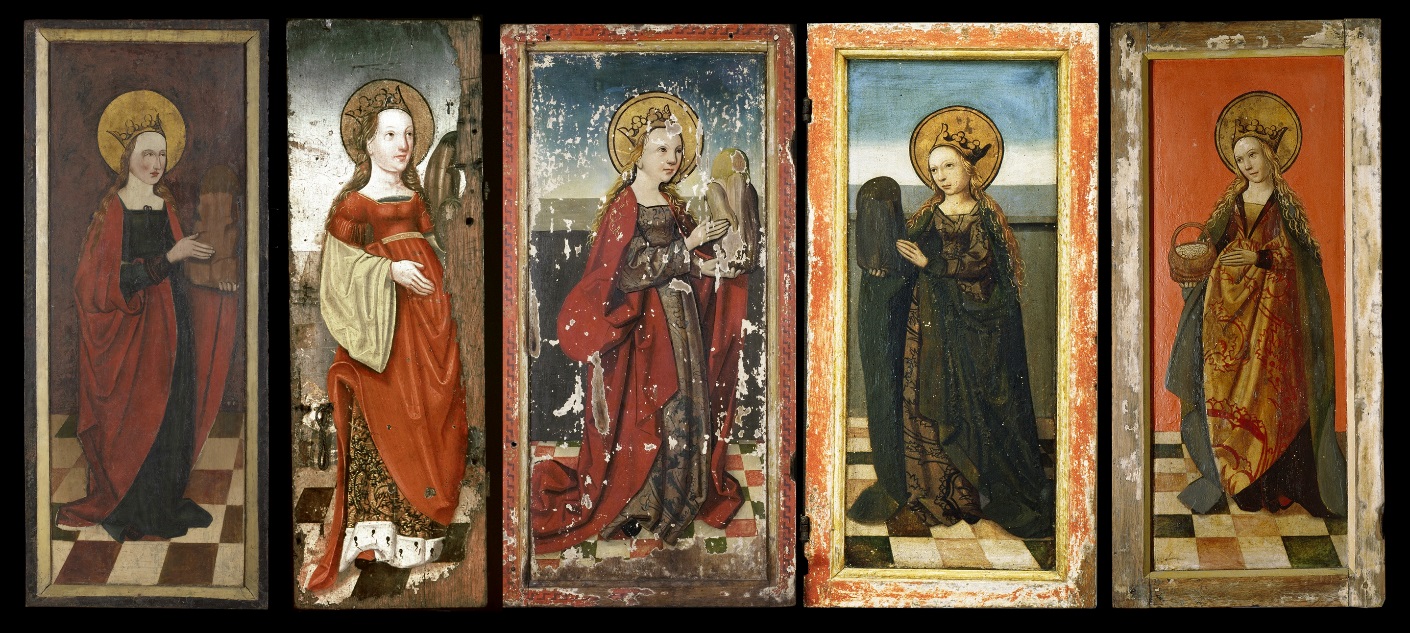
The third session, ‘Art and Conflict’, opened with Morwenna Blewett (Worcester College and Ashmolean Museum, University of Oxofrd) on the subject of the British Intelligence Objectives Sub-committee (BIOS), composed of British government officials who were sent to Germany after the Second World War to report back on technical and scientific industries, including the manufacture of artists’ materials. Consulting information from manufacturers’ archives, including that of Winsor and Newton at the HKI, Blewett described how the advances of German industries were exploited in the years following the war through the internment of German scientists in Britain and their employment at institutions such as the National Gallery. The talk highlighted a striking example of forced migration that is rarely considered in the context of the horrors of the war.
Dr Roderick Bailey (Wellcome Unit for the History of Medicine, Universityof Oxford) gave insight into the work of another British investigative group following the Second World War, the Monuments, Fine Arts and Archives (MFAA) sub-commission, who supported and educated the Greek authorities in the protection of ancient monuments such as the Parthenon and other buildings in the Acropolis, which had suffered many forms of damage during the war. However, illustrating the war damage sustained by a Jewish synagogue, Bailey also highlighted the limits of their work and the implications for the heritage of certain other cultural communities in wartime Greece.
Charlotte Bank (Art historian and independent curator) discussed the work of Syrian artists throughout the world, displaced by war from their homes. Through several case studies of artworks exhibited by the artists in several European cities, Bank showed how these individuals have used art as a platform to express their responses to their experiences and connect with their new cultural environments. However, she also warned of the ease with which viewers can become blind to all other interpretations of their work. Through highlighting their unique experiences and personalities, the talk served as a reminder to avoid the exploitation and pigeonholing of Syrian refugee artists as ‘war artists’.
On the second day, Dr Eckart Marchand (Warburg Institute/International Research Project Bilderfahrzeuge) kicked off the first session, ‘Materials and Techniques’, with his talk on the subject of Plaster of Paris, focusing on the Lucchinese figurinai, a community of peripatetic craftsmen from Barga who made popular plaster figurines (‘formatori’) and journeyed with their wares to Germany and America, where the craft gained particular prominence in the 19th century. This was a remarkable example, recalling the mosaics discussed by Grossutti, of how a small craft local to a particular geographical area can spread and become an international phenomenon, its identity evolving along the way.
Felicia Gottman (Northumbria University) spoke about the role of migration within the cotton industry in 18th-century France, focusing on the career of textile manufacturer Jean-Claude Flachat, who imported workers from the Levant and expanded his industry exploiting the knowledge and technologies they brought with them. Gottman considered Flachat’s enterprise in the context of the Actor-Network Theory, focusing on the role of ‘non-traditional agencies’ – the cotton, the technologies, and the experiences of the workers – through which knowledge was transferred and developments ensued in cotton manufacture and trade.
Jenny Bulstrode’s paper (University of Cambridge) explored the many identities of copper, ranging from its elemental properties to its geographical source in the mines of Cornwall and Australia, its manifestation as trade tokens and ship hull sheathing, and its use in tribal masks. The talk demonstrated how copper has been exploited historically to advance technologies and cultures, and the distances the material has travelled between countries, from the depths of the Earth and through time. The talk highlighted that migration can refer to the changing identities of a given material as it migrates itself through time and between cultures.
Jacob Simon (National Portrait Gallery) discussed the impact of migration on the transfer of artists’ materials between countries from the 18th through to the 20th centuries. Simon documented the competition between manufacturers as materials were exported and supply chains for British and other European manufacturers established in several countries. He conveyed the complex exchange of influences and materials between British and foreign suppliers, which also impacted on where artists settled and how they chose to develop their art. Ultimately, Simon concluded that this last consideration comes down to the three factors of material quality, permanence, and price.
After lunch on the second day we had an excellent introduction to the collection of paintings at Murray Edwards College, which showcases over 500 works and represents the second largest collection in the world of contemporary women artists. Many of the paintings were on display around the college and we had a wonderful opportunity to explore.
Opening the final session, ‘Transmitting Ideas’, Karen French, representing the Walters Art Museum and colleagues Christine Sciaccia, Glenn Gates and Hae Min Park, gave a talk on the late medieval Ethiopian religious paintings currently undergoing technical research in a collaborative project at the Walters Art Museum, Baltimore. Describing the popularity in Ethiopia of religious imagery and cults from the Western Christian church from the 15th century, French discussed the exchange of ideas with Italian painters brought to the country, focusing on the art icon painter Fre Seyon. French pointed out examples of the influence of Italian painting on aspects of the iconography, but also revealed interesting divergences regarding the materials and techniques.
Julia Brandt and her colleagues Isabel Wagner and Corinna Gramatke (Technical University Munich) presented new research, currently in progress, on the art of the Jesuits who populated South America in the 17th century, imposing their religion and art on the indigenous Guarani people. The cultural influence appears to have been strictly concentrated in one direction, unlike the exchanges featured in some of the other talks. This example of art and culture enforced on the people was an interesting comparison to the conscious decision to pursue western religious doctrine by the Ethiopian emperors discussed in the previous paper.
Esmee Schoutens and her colleagues Rosa Mulder and Janneke Sif Rutten (VU University, Amsterdam and University of Leiden) presented collaborative research undertaken recently into the geographical representation of artists in the collections at the Stedelijk Museum. Using digital software to collect and organise the data from the collection from 1896 (the Museum’s foundation date) to 2003, trends were noted that showed, for example, that artists from Eastern Europe were well represented but those from the Middle East were not. This led to more complicated questions including whether some artists’ work only appears in the collections because they were working at that time in a ‘geographically represented’ region. This ongoing research demonstrates the information that can be gleaned from a study of such a significant world-class collection of modern and contemporary art.
The opportunities for discussion, led excellently by all of the chairs – Vicky Sutcliffe and Sally Woodcock (Hamilton Kerr Institute), Dr Alexander Marr, Professor Simon Schaffer and Professor Mary Laven (University of Cambridge), and Dr Abbie Vandivere (Mauritshuis/University of Amsterdam) – resulted in the emergence of notable links between even the most divergent talks. We saw examples of migration across vast geographical distances and across time. We were shown how migrants have often been perceived or conveyed throughout history as a ‘package deal’ comprising the labour, experience, skills and technologies of their craft. It was emphasised how migration is rarely in a single direction, with cultural exchanges taking place and the existence of complex networks of artists and industries established between different cultures. Also demonstrated were the results of when migration is prohibited or enforced upon peoples, and we came to appreciate the many different situations that have led to migration – voluntary or otherwise – by artists, crafts and materials over the centuries. Perhaps most compelling was the revelation of the individual stories of the artists and innovators that have travelled throughout history; the anonymous voices known predominantly through artefacts and rarely acknowledged in the wake of more prominent historical figures.
Overall, at a time when words and phrases such as ‘take back control’, ‘borders’, and ‘independence’ are in constant repetition, and when migration is so often portrayed as a ‘good’ or ‘bad’ phenomenon, it was refreshing to explore with the speakers its many possible definitions and faces, to challenge the notions of borders and peripheries, and reveal the more nuanced picture of migration that historical events, individuals and artefacts convey.
Closing remarks were given by Dr Spike Bucklow (Hamilton Kerr Institute), who highlighted that the conference demonstrated how much can be learnt when we cross disciplinary boundaries and hear from colleagues around the world working in different fields of conservation, technical art history, as well as history and art history, science and archaeology.

Katharine Waldron – 1st year Post Graduate Intern at the Hamilton Kerr Institute
About the Author
After completing a BA in History of Art at the University of Warwick, Katharine graduated from The Courtauld Institute of Art in 2018 with a Postgraduate Diploma in the Conservation of Easel Paintings. One of her projects involved the conservation and technical research of a modified 17th-century harpsichord lid, leading to her third-year dissertation project which focused on the characterisation and deterioration of historical copper green glazes. She has worked for Katherine Ara Ltd. and completed paintings conservation internships with the National Trust, the House of Lords, the National Maritime Museum, the V&A, and the RCE in the Netherlands as a Zibby Garnett scholar. Among her current projects at the HKI, Katharine is involved with research into the pigments and techniques of medieval rood screens and church polychromy in East Anglia.
To contact Katharine: kjw74@cam.ac.uk

